Australian Commercial Law Assignment: Contract and Misrepresentation
VerifiedAdded on 2021/05/30
|11
|2772
|251
Homework Assignment
AI Summary
This assignment solution addresses key concepts in Australian Commercial Law, including the doctrine of precedent and the Hart three-part legal system. Part A examines a hypothetical constitution, drawing parallels with the Australian legal system. Part B delves into contract law, focusing on misrepresentation, particularly fraudulent misrepresentation, and its implications. The assignment analyzes a scenario where a business sale is affected by misleading statements, determining the rights of the parties involved, including the right to rescind the contract and claim damages. Answer 3 examines breach of contract, focusing on the legal principles of contract and misrepresentation. The solution concludes that Barry has the right to make a claim for misrepresentation as the statements which had been made by Angelo to induce Barry into the contract were untrue, and Angelo has committed fraudulent misrepresentation. Barry is entitled to rescind the contract and claim any damages which have arisen out of the contract.
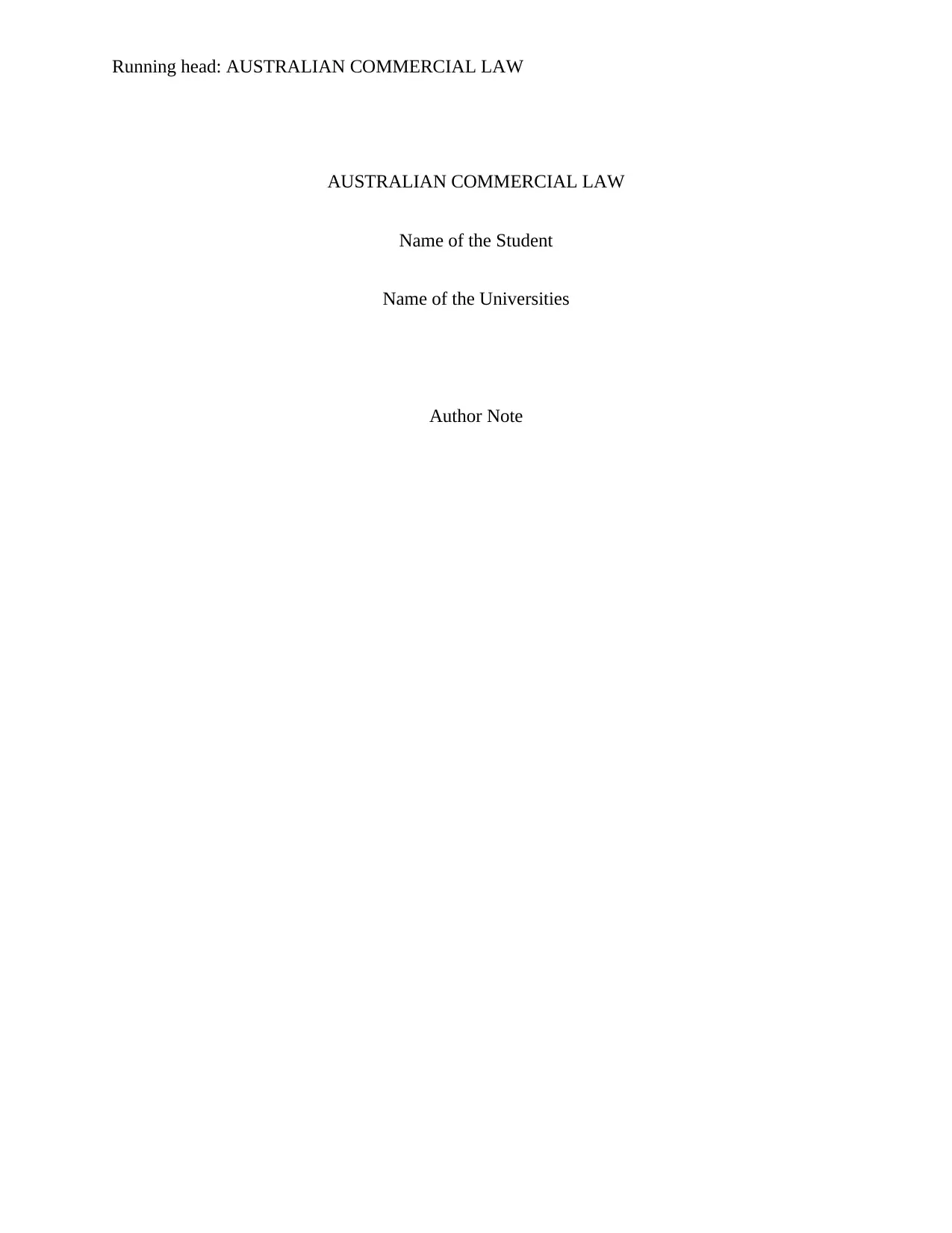
Running head: AUSTRALIAN COMMERCIAL LAW
AUSTRALIAN COMMERCIAL LAW
Name of the Student
Name of the Universities
Author Note
AUSTRALIAN COMMERCIAL LAW
Name of the Student
Name of the Universities
Author Note
Paraphrase This Document
Need a fresh take? Get an instant paraphrase of this document with our AI Paraphraser
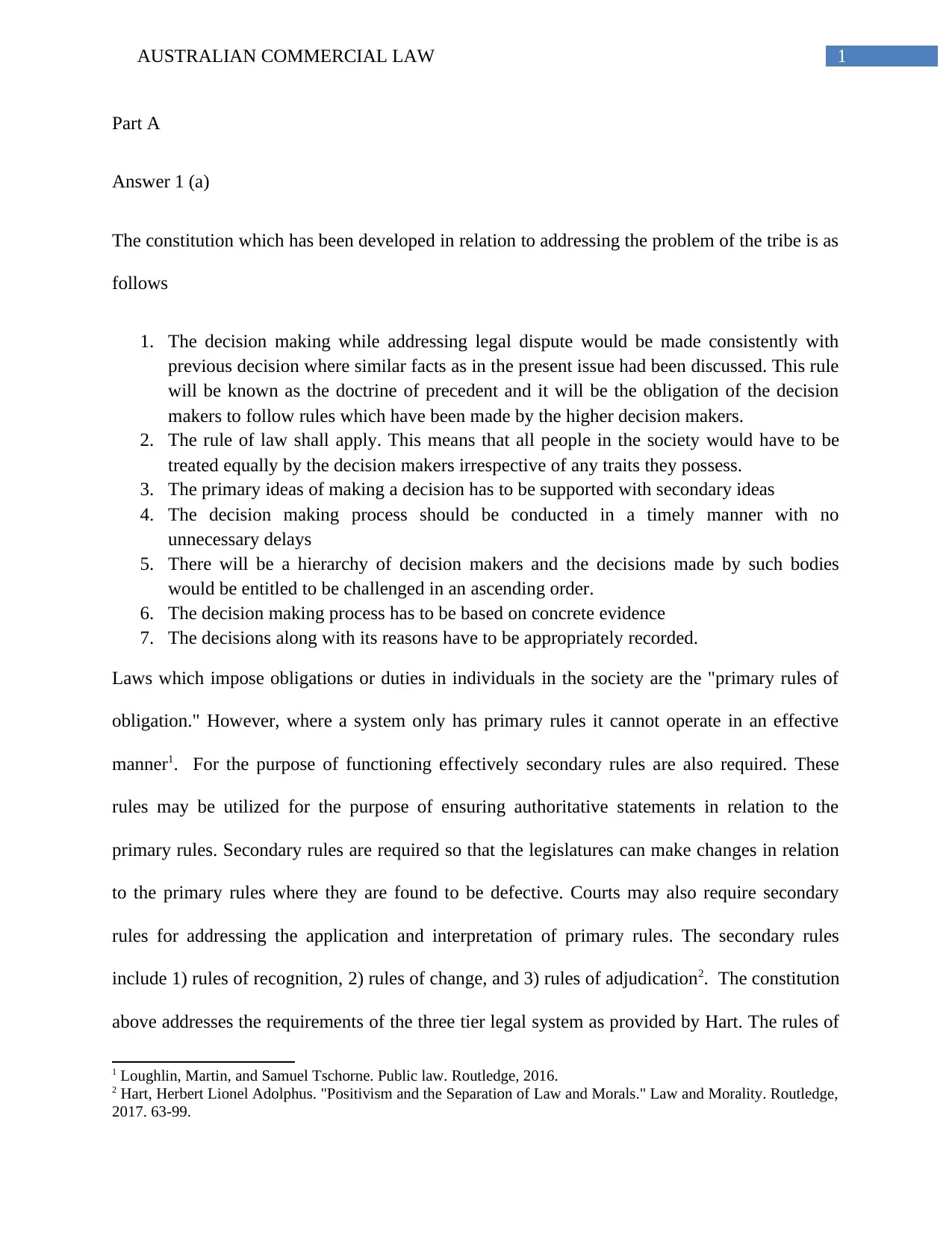
1AUSTRALIAN COMMERCIAL LAW
Part A
Answer 1 (a)
The constitution which has been developed in relation to addressing the problem of the tribe is as
follows
1. The decision making while addressing legal dispute would be made consistently with
previous decision where similar facts as in the present issue had been discussed. This rule
will be known as the doctrine of precedent and it will be the obligation of the decision
makers to follow rules which have been made by the higher decision makers.
2. The rule of law shall apply. This means that all people in the society would have to be
treated equally by the decision makers irrespective of any traits they possess.
3. The primary ideas of making a decision has to be supported with secondary ideas
4. The decision making process should be conducted in a timely manner with no
unnecessary delays
5. There will be a hierarchy of decision makers and the decisions made by such bodies
would be entitled to be challenged in an ascending order.
6. The decision making process has to be based on concrete evidence
7. The decisions along with its reasons have to be appropriately recorded.
Laws which impose obligations or duties in individuals in the society are the "primary rules of
obligation." However, where a system only has primary rules it cannot operate in an effective
manner1. For the purpose of functioning effectively secondary rules are also required. These
rules may be utilized for the purpose of ensuring authoritative statements in relation to the
primary rules. Secondary rules are required so that the legislatures can make changes in relation
to the primary rules where they are found to be defective. Courts may also require secondary
rules for addressing the application and interpretation of primary rules. The secondary rules
include 1) rules of recognition, 2) rules of change, and 3) rules of adjudication2. The constitution
above addresses the requirements of the three tier legal system as provided by Hart. The rules of
1 Loughlin, Martin, and Samuel Tschorne. Public law. Routledge, 2016.
2 Hart, Herbert Lionel Adolphus. "Positivism and the Separation of Law and Morals." Law and Morality. Routledge,
2017. 63-99.
Part A
Answer 1 (a)
The constitution which has been developed in relation to addressing the problem of the tribe is as
follows
1. The decision making while addressing legal dispute would be made consistently with
previous decision where similar facts as in the present issue had been discussed. This rule
will be known as the doctrine of precedent and it will be the obligation of the decision
makers to follow rules which have been made by the higher decision makers.
2. The rule of law shall apply. This means that all people in the society would have to be
treated equally by the decision makers irrespective of any traits they possess.
3. The primary ideas of making a decision has to be supported with secondary ideas
4. The decision making process should be conducted in a timely manner with no
unnecessary delays
5. There will be a hierarchy of decision makers and the decisions made by such bodies
would be entitled to be challenged in an ascending order.
6. The decision making process has to be based on concrete evidence
7. The decisions along with its reasons have to be appropriately recorded.
Laws which impose obligations or duties in individuals in the society are the "primary rules of
obligation." However, where a system only has primary rules it cannot operate in an effective
manner1. For the purpose of functioning effectively secondary rules are also required. These
rules may be utilized for the purpose of ensuring authoritative statements in relation to the
primary rules. Secondary rules are required so that the legislatures can make changes in relation
to the primary rules where they are found to be defective. Courts may also require secondary
rules for addressing the application and interpretation of primary rules. The secondary rules
include 1) rules of recognition, 2) rules of change, and 3) rules of adjudication2. The constitution
above addresses the requirements of the three tier legal system as provided by Hart. The rules of
1 Loughlin, Martin, and Samuel Tschorne. Public law. Routledge, 2016.
2 Hart, Herbert Lionel Adolphus. "Positivism and the Separation of Law and Morals." Law and Morality. Routledge,
2017. 63-99.
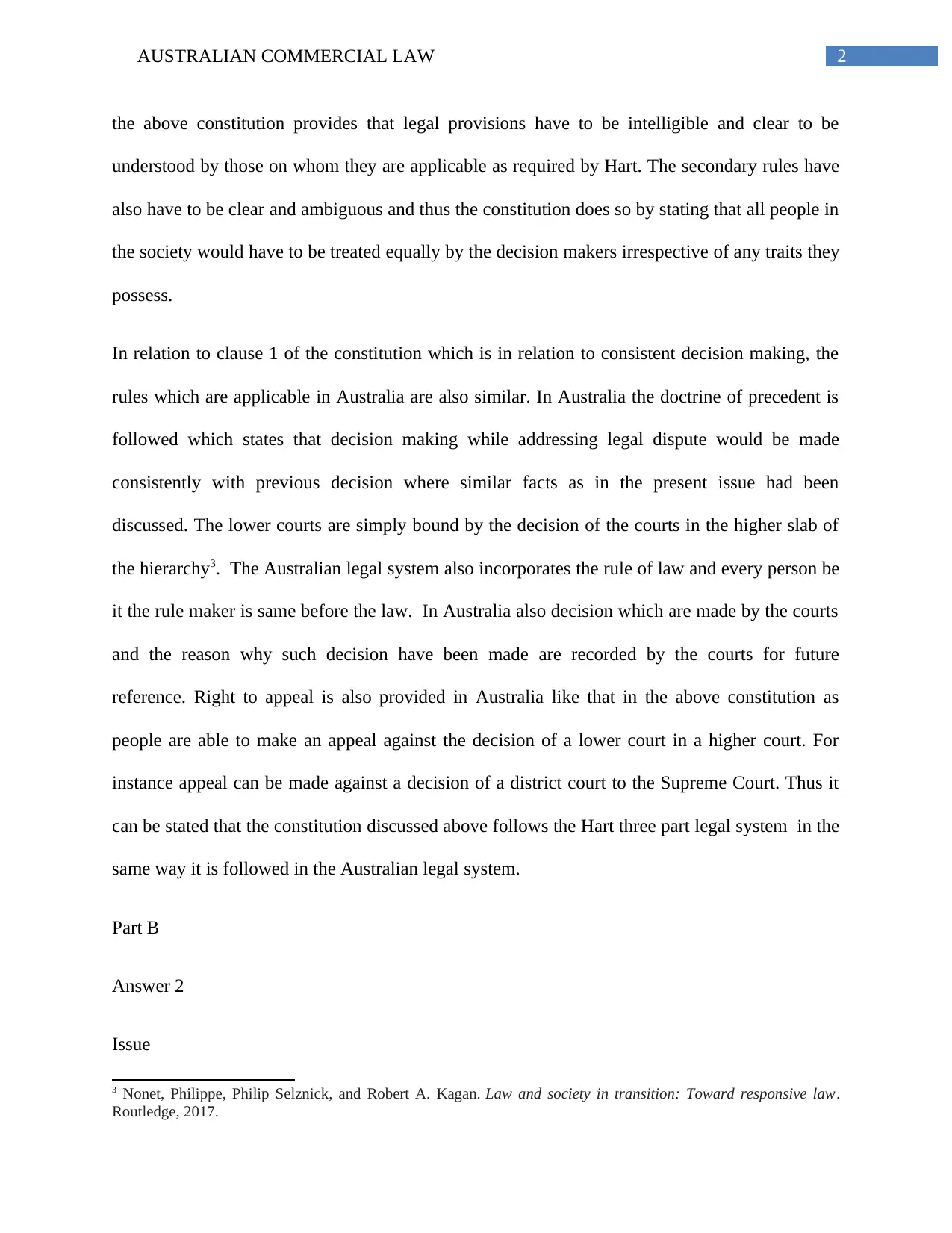
2AUSTRALIAN COMMERCIAL LAW
the above constitution provides that legal provisions have to be intelligible and clear to be
understood by those on whom they are applicable as required by Hart. The secondary rules have
also have to be clear and ambiguous and thus the constitution does so by stating that all people in
the society would have to be treated equally by the decision makers irrespective of any traits they
possess.
In relation to clause 1 of the constitution which is in relation to consistent decision making, the
rules which are applicable in Australia are also similar. In Australia the doctrine of precedent is
followed which states that decision making while addressing legal dispute would be made
consistently with previous decision where similar facts as in the present issue had been
discussed. The lower courts are simply bound by the decision of the courts in the higher slab of
the hierarchy3. The Australian legal system also incorporates the rule of law and every person be
it the rule maker is same before the law. In Australia also decision which are made by the courts
and the reason why such decision have been made are recorded by the courts for future
reference. Right to appeal is also provided in Australia like that in the above constitution as
people are able to make an appeal against the decision of a lower court in a higher court. For
instance appeal can be made against a decision of a district court to the Supreme Court. Thus it
can be stated that the constitution discussed above follows the Hart three part legal system in the
same way it is followed in the Australian legal system.
Part B
Answer 2
Issue
3 Nonet, Philippe, Philip Selznick, and Robert A. Kagan. Law and society in transition: Toward responsive law.
Routledge, 2017.
the above constitution provides that legal provisions have to be intelligible and clear to be
understood by those on whom they are applicable as required by Hart. The secondary rules have
also have to be clear and ambiguous and thus the constitution does so by stating that all people in
the society would have to be treated equally by the decision makers irrespective of any traits they
possess.
In relation to clause 1 of the constitution which is in relation to consistent decision making, the
rules which are applicable in Australia are also similar. In Australia the doctrine of precedent is
followed which states that decision making while addressing legal dispute would be made
consistently with previous decision where similar facts as in the present issue had been
discussed. The lower courts are simply bound by the decision of the courts in the higher slab of
the hierarchy3. The Australian legal system also incorporates the rule of law and every person be
it the rule maker is same before the law. In Australia also decision which are made by the courts
and the reason why such decision have been made are recorded by the courts for future
reference. Right to appeal is also provided in Australia like that in the above constitution as
people are able to make an appeal against the decision of a lower court in a higher court. For
instance appeal can be made against a decision of a district court to the Supreme Court. Thus it
can be stated that the constitution discussed above follows the Hart three part legal system in the
same way it is followed in the Australian legal system.
Part B
Answer 2
Issue
3 Nonet, Philippe, Philip Selznick, and Robert A. Kagan. Law and society in transition: Toward responsive law.
Routledge, 2017.
⊘ This is a preview!⊘
Do you want full access?
Subscribe today to unlock all pages.

Trusted by 1+ million students worldwide
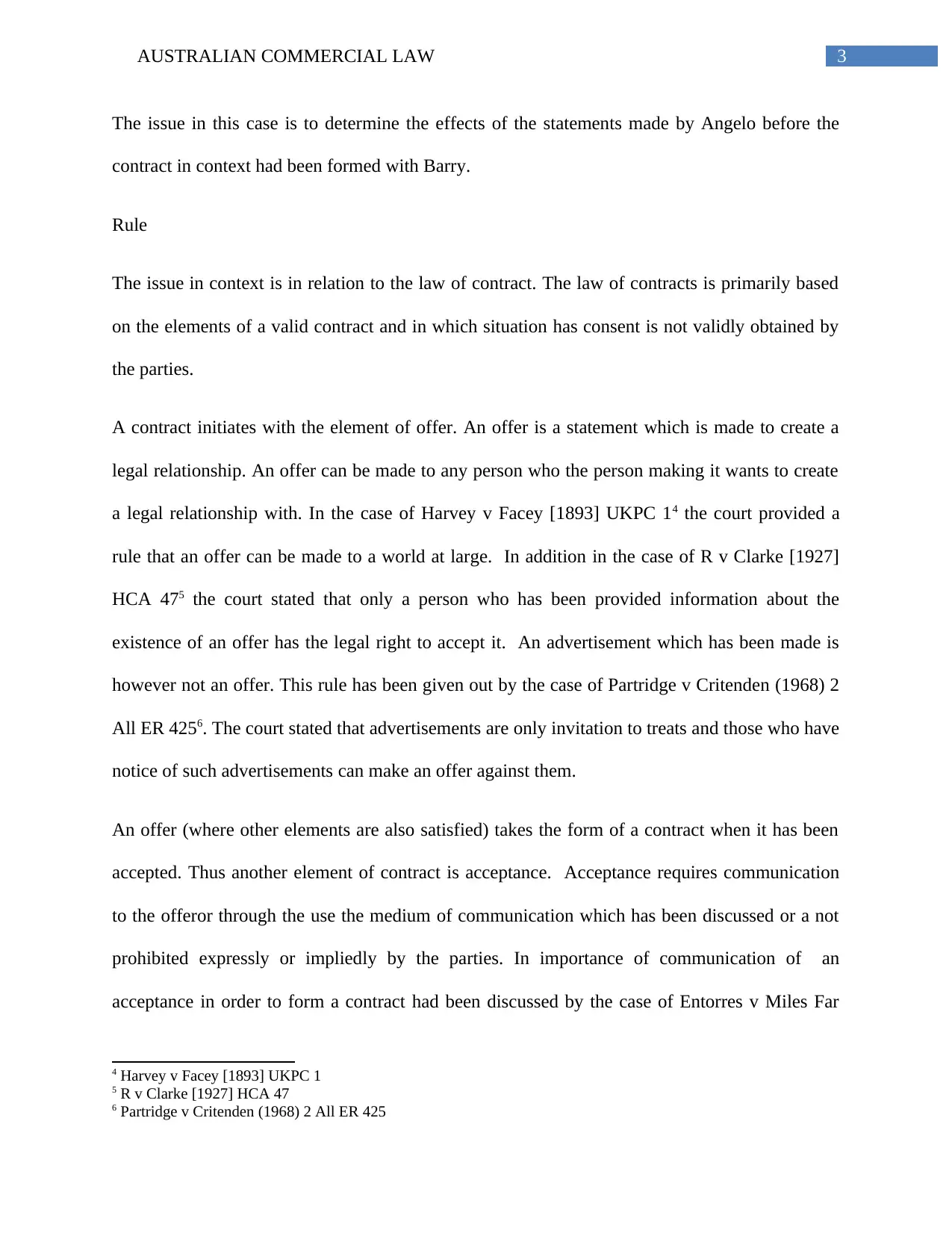
3AUSTRALIAN COMMERCIAL LAW
The issue in this case is to determine the effects of the statements made by Angelo before the
contract in context had been formed with Barry.
Rule
The issue in context is in relation to the law of contract. The law of contracts is primarily based
on the elements of a valid contract and in which situation has consent is not validly obtained by
the parties.
A contract initiates with the element of offer. An offer is a statement which is made to create a
legal relationship. An offer can be made to any person who the person making it wants to create
a legal relationship with. In the case of Harvey v Facey [1893] UKPC 14 the court provided a
rule that an offer can be made to a world at large. In addition in the case of R v Clarke [1927]
HCA 475 the court stated that only a person who has been provided information about the
existence of an offer has the legal right to accept it. An advertisement which has been made is
however not an offer. This rule has been given out by the case of Partridge v Critenden (1968) 2
All ER 4256. The court stated that advertisements are only invitation to treats and those who have
notice of such advertisements can make an offer against them.
An offer (where other elements are also satisfied) takes the form of a contract when it has been
accepted. Thus another element of contract is acceptance. Acceptance requires communication
to the offeror through the use the medium of communication which has been discussed or a not
prohibited expressly or impliedly by the parties. In importance of communication of an
acceptance in order to form a contract had been discussed by the case of Entorres v Miles Far
4 Harvey v Facey [1893] UKPC 1
5 R v Clarke [1927] HCA 47
6 Partridge v Critenden (1968) 2 All ER 425
The issue in this case is to determine the effects of the statements made by Angelo before the
contract in context had been formed with Barry.
Rule
The issue in context is in relation to the law of contract. The law of contracts is primarily based
on the elements of a valid contract and in which situation has consent is not validly obtained by
the parties.
A contract initiates with the element of offer. An offer is a statement which is made to create a
legal relationship. An offer can be made to any person who the person making it wants to create
a legal relationship with. In the case of Harvey v Facey [1893] UKPC 14 the court provided a
rule that an offer can be made to a world at large. In addition in the case of R v Clarke [1927]
HCA 475 the court stated that only a person who has been provided information about the
existence of an offer has the legal right to accept it. An advertisement which has been made is
however not an offer. This rule has been given out by the case of Partridge v Critenden (1968) 2
All ER 4256. The court stated that advertisements are only invitation to treats and those who have
notice of such advertisements can make an offer against them.
An offer (where other elements are also satisfied) takes the form of a contract when it has been
accepted. Thus another element of contract is acceptance. Acceptance requires communication
to the offeror through the use the medium of communication which has been discussed or a not
prohibited expressly or impliedly by the parties. In importance of communication of an
acceptance in order to form a contract had been discussed by the case of Entorres v Miles Far
4 Harvey v Facey [1893] UKPC 1
5 R v Clarke [1927] HCA 47
6 Partridge v Critenden (1968) 2 All ER 425
Paraphrase This Document
Need a fresh take? Get an instant paraphrase of this document with our AI Paraphraser
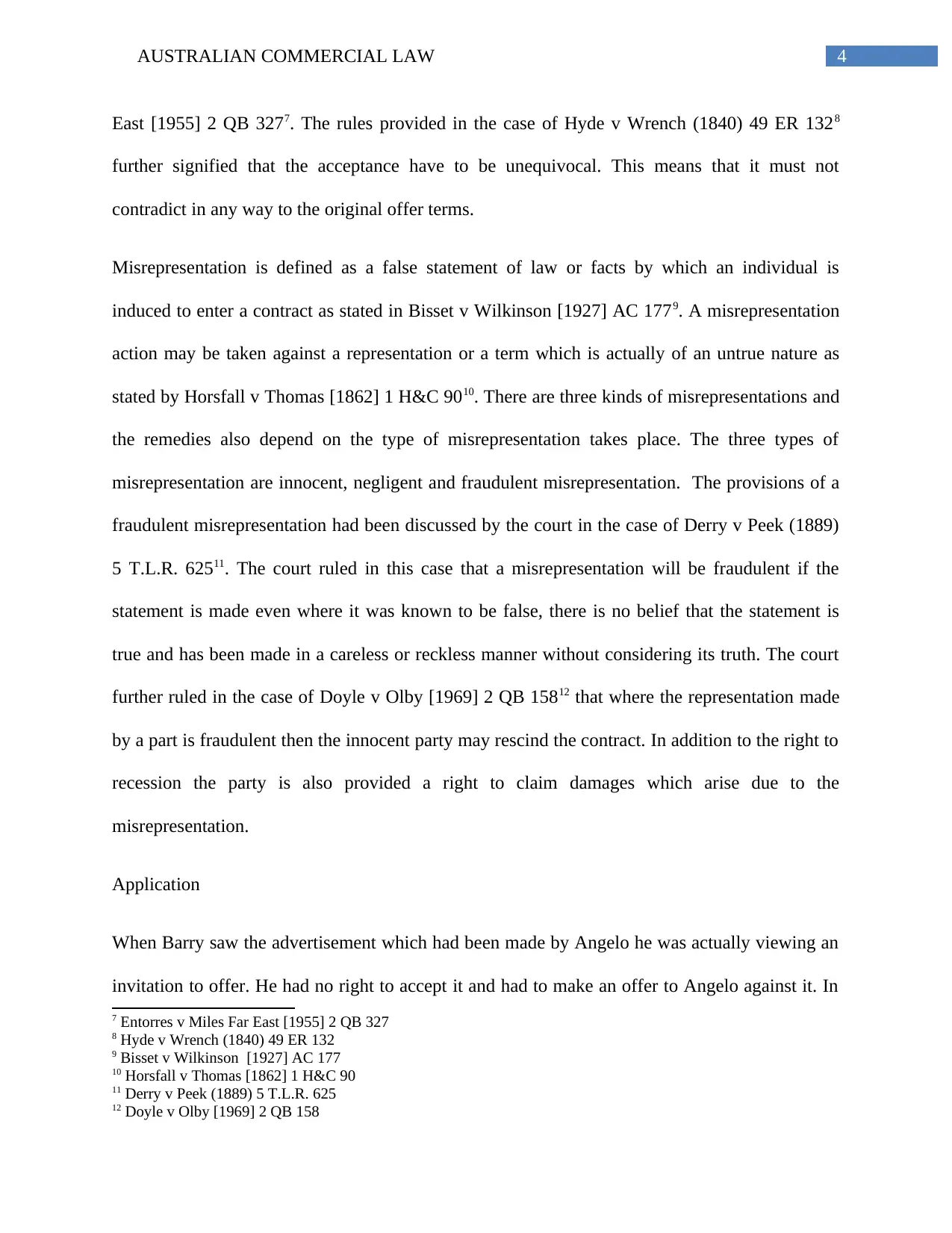
4AUSTRALIAN COMMERCIAL LAW
East [1955] 2 QB 3277. The rules provided in the case of Hyde v Wrench (1840) 49 ER 1328
further signified that the acceptance have to be unequivocal. This means that it must not
contradict in any way to the original offer terms.
Misrepresentation is defined as a false statement of law or facts by which an individual is
induced to enter a contract as stated in Bisset v Wilkinson [1927] AC 1779. A misrepresentation
action may be taken against a representation or a term which is actually of an untrue nature as
stated by Horsfall v Thomas [1862] 1 H&C 9010. There are three kinds of misrepresentations and
the remedies also depend on the type of misrepresentation takes place. The three types of
misrepresentation are innocent, negligent and fraudulent misrepresentation. The provisions of a
fraudulent misrepresentation had been discussed by the court in the case of Derry v Peek (1889)
5 T.L.R. 62511. The court ruled in this case that a misrepresentation will be fraudulent if the
statement is made even where it was known to be false, there is no belief that the statement is
true and has been made in a careless or reckless manner without considering its truth. The court
further ruled in the case of Doyle v Olby [1969] 2 QB 15812 that where the representation made
by a part is fraudulent then the innocent party may rescind the contract. In addition to the right to
recession the party is also provided a right to claim damages which arise due to the
misrepresentation.
Application
When Barry saw the advertisement which had been made by Angelo he was actually viewing an
invitation to offer. He had no right to accept it and had to make an offer to Angelo against it. In
7 Entorres v Miles Far East [1955] 2 QB 327
8 Hyde v Wrench (1840) 49 ER 132
9 Bisset v Wilkinson [1927] AC 177
10 Horsfall v Thomas [1862] 1 H&C 90
11 Derry v Peek (1889) 5 T.L.R. 625
12 Doyle v Olby [1969] 2 QB 158
East [1955] 2 QB 3277. The rules provided in the case of Hyde v Wrench (1840) 49 ER 1328
further signified that the acceptance have to be unequivocal. This means that it must not
contradict in any way to the original offer terms.
Misrepresentation is defined as a false statement of law or facts by which an individual is
induced to enter a contract as stated in Bisset v Wilkinson [1927] AC 1779. A misrepresentation
action may be taken against a representation or a term which is actually of an untrue nature as
stated by Horsfall v Thomas [1862] 1 H&C 9010. There are three kinds of misrepresentations and
the remedies also depend on the type of misrepresentation takes place. The three types of
misrepresentation are innocent, negligent and fraudulent misrepresentation. The provisions of a
fraudulent misrepresentation had been discussed by the court in the case of Derry v Peek (1889)
5 T.L.R. 62511. The court ruled in this case that a misrepresentation will be fraudulent if the
statement is made even where it was known to be false, there is no belief that the statement is
true and has been made in a careless or reckless manner without considering its truth. The court
further ruled in the case of Doyle v Olby [1969] 2 QB 15812 that where the representation made
by a part is fraudulent then the innocent party may rescind the contract. In addition to the right to
recession the party is also provided a right to claim damages which arise due to the
misrepresentation.
Application
When Barry saw the advertisement which had been made by Angelo he was actually viewing an
invitation to offer. He had no right to accept it and had to make an offer to Angelo against it. In
7 Entorres v Miles Far East [1955] 2 QB 327
8 Hyde v Wrench (1840) 49 ER 132
9 Bisset v Wilkinson [1927] AC 177
10 Horsfall v Thomas [1862] 1 H&C 90
11 Derry v Peek (1889) 5 T.L.R. 625
12 Doyle v Olby [1969] 2 QB 158
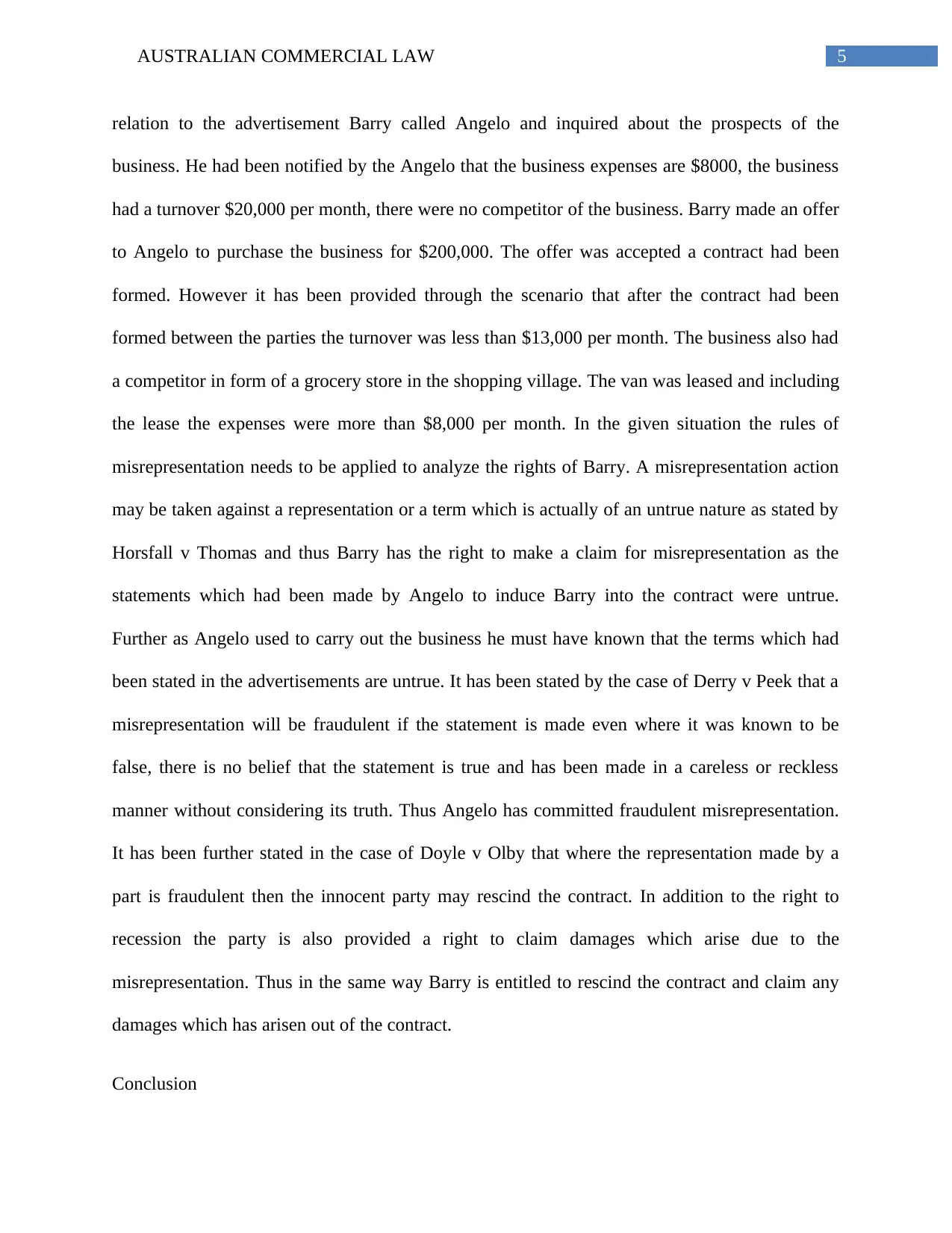
5AUSTRALIAN COMMERCIAL LAW
relation to the advertisement Barry called Angelo and inquired about the prospects of the
business. He had been notified by the Angelo that the business expenses are $8000, the business
had a turnover $20,000 per month, there were no competitor of the business. Barry made an offer
to Angelo to purchase the business for $200,000. The offer was accepted a contract had been
formed. However it has been provided through the scenario that after the contract had been
formed between the parties the turnover was less than $13,000 per month. The business also had
a competitor in form of a grocery store in the shopping village. The van was leased and including
the lease the expenses were more than $8,000 per month. In the given situation the rules of
misrepresentation needs to be applied to analyze the rights of Barry. A misrepresentation action
may be taken against a representation or a term which is actually of an untrue nature as stated by
Horsfall v Thomas and thus Barry has the right to make a claim for misrepresentation as the
statements which had been made by Angelo to induce Barry into the contract were untrue.
Further as Angelo used to carry out the business he must have known that the terms which had
been stated in the advertisements are untrue. It has been stated by the case of Derry v Peek that a
misrepresentation will be fraudulent if the statement is made even where it was known to be
false, there is no belief that the statement is true and has been made in a careless or reckless
manner without considering its truth. Thus Angelo has committed fraudulent misrepresentation.
It has been further stated in the case of Doyle v Olby that where the representation made by a
part is fraudulent then the innocent party may rescind the contract. In addition to the right to
recession the party is also provided a right to claim damages which arise due to the
misrepresentation. Thus in the same way Barry is entitled to rescind the contract and claim any
damages which has arisen out of the contract.
Conclusion
relation to the advertisement Barry called Angelo and inquired about the prospects of the
business. He had been notified by the Angelo that the business expenses are $8000, the business
had a turnover $20,000 per month, there were no competitor of the business. Barry made an offer
to Angelo to purchase the business for $200,000. The offer was accepted a contract had been
formed. However it has been provided through the scenario that after the contract had been
formed between the parties the turnover was less than $13,000 per month. The business also had
a competitor in form of a grocery store in the shopping village. The van was leased and including
the lease the expenses were more than $8,000 per month. In the given situation the rules of
misrepresentation needs to be applied to analyze the rights of Barry. A misrepresentation action
may be taken against a representation or a term which is actually of an untrue nature as stated by
Horsfall v Thomas and thus Barry has the right to make a claim for misrepresentation as the
statements which had been made by Angelo to induce Barry into the contract were untrue.
Further as Angelo used to carry out the business he must have known that the terms which had
been stated in the advertisements are untrue. It has been stated by the case of Derry v Peek that a
misrepresentation will be fraudulent if the statement is made even where it was known to be
false, there is no belief that the statement is true and has been made in a careless or reckless
manner without considering its truth. Thus Angelo has committed fraudulent misrepresentation.
It has been further stated in the case of Doyle v Olby that where the representation made by a
part is fraudulent then the innocent party may rescind the contract. In addition to the right to
recession the party is also provided a right to claim damages which arise due to the
misrepresentation. Thus in the same way Barry is entitled to rescind the contract and claim any
damages which has arisen out of the contract.
Conclusion
⊘ This is a preview!⊘
Do you want full access?
Subscribe today to unlock all pages.

Trusted by 1+ million students worldwide
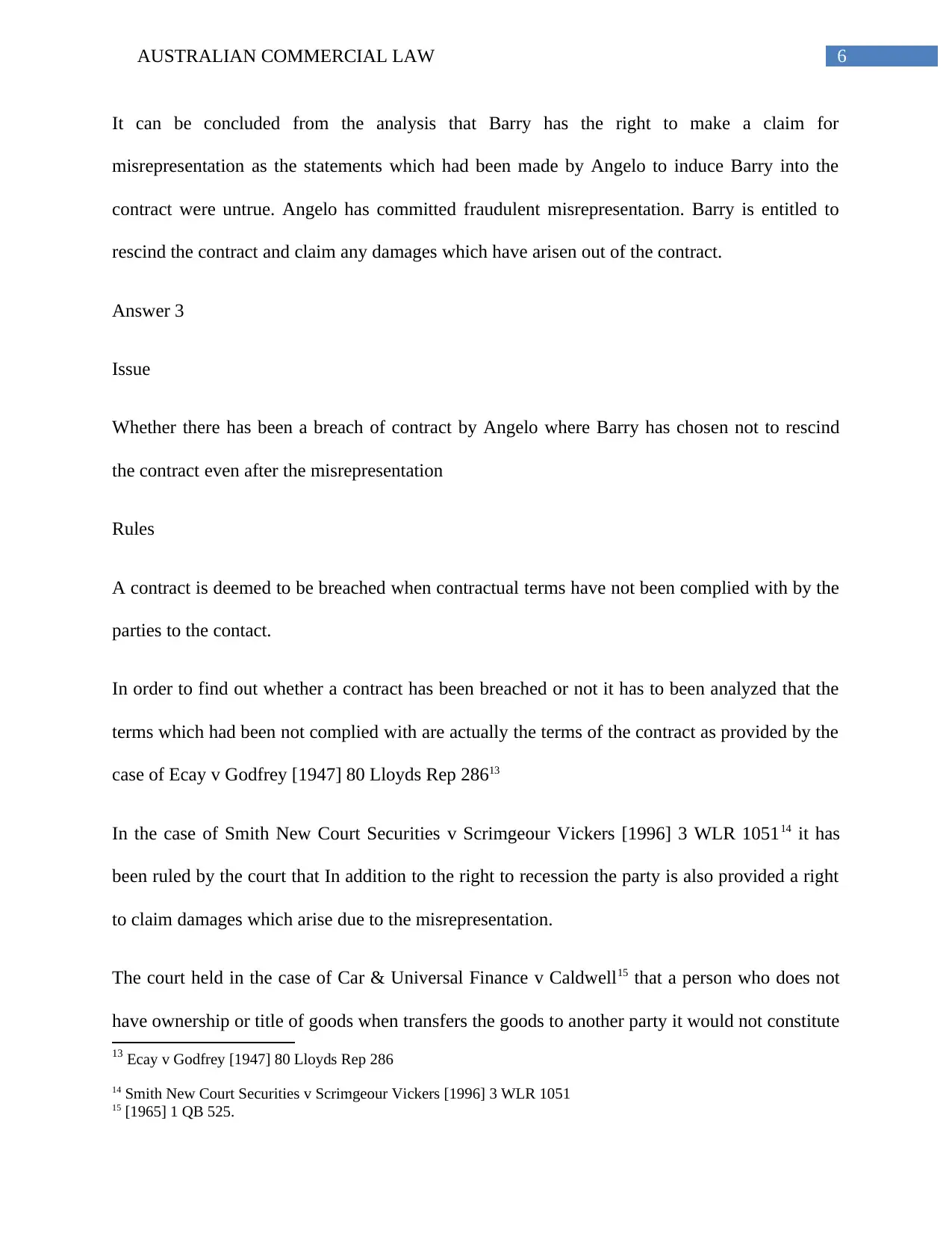
6AUSTRALIAN COMMERCIAL LAW
It can be concluded from the analysis that Barry has the right to make a claim for
misrepresentation as the statements which had been made by Angelo to induce Barry into the
contract were untrue. Angelo has committed fraudulent misrepresentation. Barry is entitled to
rescind the contract and claim any damages which have arisen out of the contract.
Answer 3
Issue
Whether there has been a breach of contract by Angelo where Barry has chosen not to rescind
the contract even after the misrepresentation
Rules
A contract is deemed to be breached when contractual terms have not been complied with by the
parties to the contact.
In order to find out whether a contract has been breached or not it has to been analyzed that the
terms which had been not complied with are actually the terms of the contract as provided by the
case of Ecay v Godfrey [1947] 80 Lloyds Rep 28613
In the case of Smith New Court Securities v Scrimgeour Vickers [1996] 3 WLR 105114 it has
been ruled by the court that In addition to the right to recession the party is also provided a right
to claim damages which arise due to the misrepresentation.
The court held in the case of Car & Universal Finance v Caldwell15 that a person who does not
have ownership or title of goods when transfers the goods to another party it would not constitute
13 Ecay v Godfrey [1947] 80 Lloyds Rep 286
14 Smith New Court Securities v Scrimgeour Vickers [1996] 3 WLR 1051
15 [1965] 1 QB 525.
It can be concluded from the analysis that Barry has the right to make a claim for
misrepresentation as the statements which had been made by Angelo to induce Barry into the
contract were untrue. Angelo has committed fraudulent misrepresentation. Barry is entitled to
rescind the contract and claim any damages which have arisen out of the contract.
Answer 3
Issue
Whether there has been a breach of contract by Angelo where Barry has chosen not to rescind
the contract even after the misrepresentation
Rules
A contract is deemed to be breached when contractual terms have not been complied with by the
parties to the contact.
In order to find out whether a contract has been breached or not it has to been analyzed that the
terms which had been not complied with are actually the terms of the contract as provided by the
case of Ecay v Godfrey [1947] 80 Lloyds Rep 28613
In the case of Smith New Court Securities v Scrimgeour Vickers [1996] 3 WLR 105114 it has
been ruled by the court that In addition to the right to recession the party is also provided a right
to claim damages which arise due to the misrepresentation.
The court held in the case of Car & Universal Finance v Caldwell15 that a person who does not
have ownership or title of goods when transfers the goods to another party it would not constitute
13 Ecay v Godfrey [1947] 80 Lloyds Rep 286
14 Smith New Court Securities v Scrimgeour Vickers [1996] 3 WLR 1051
15 [1965] 1 QB 525.
Paraphrase This Document
Need a fresh take? Get an instant paraphrase of this document with our AI Paraphraser
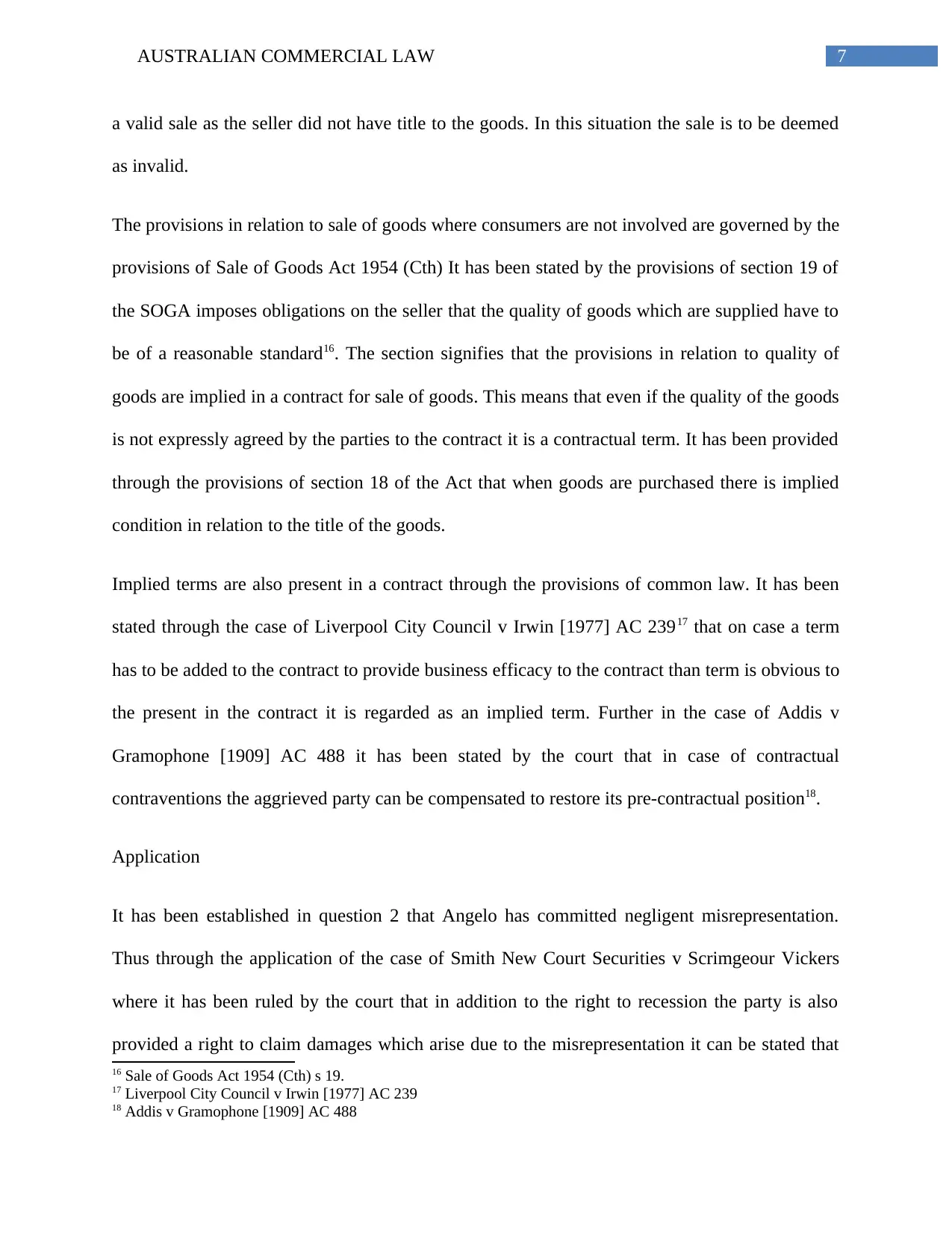
7AUSTRALIAN COMMERCIAL LAW
a valid sale as the seller did not have title to the goods. In this situation the sale is to be deemed
as invalid.
The provisions in relation to sale of goods where consumers are not involved are governed by the
provisions of Sale of Goods Act 1954 (Cth) It has been stated by the provisions of section 19 of
the SOGA imposes obligations on the seller that the quality of goods which are supplied have to
be of a reasonable standard16. The section signifies that the provisions in relation to quality of
goods are implied in a contract for sale of goods. This means that even if the quality of the goods
is not expressly agreed by the parties to the contract it is a contractual term. It has been provided
through the provisions of section 18 of the Act that when goods are purchased there is implied
condition in relation to the title of the goods.
Implied terms are also present in a contract through the provisions of common law. It has been
stated through the case of Liverpool City Council v Irwin [1977] AC 23917 that on case a term
has to be added to the contract to provide business efficacy to the contract than term is obvious to
the present in the contract it is regarded as an implied term. Further in the case of Addis v
Gramophone [1909] AC 488 it has been stated by the court that in case of contractual
contraventions the aggrieved party can be compensated to restore its pre-contractual position18.
Application
It has been established in question 2 that Angelo has committed negligent misrepresentation.
Thus through the application of the case of Smith New Court Securities v Scrimgeour Vickers
where it has been ruled by the court that in addition to the right to recession the party is also
provided a right to claim damages which arise due to the misrepresentation it can be stated that
16 Sale of Goods Act 1954 (Cth) s 19.
17 Liverpool City Council v Irwin [1977] AC 239
18 Addis v Gramophone [1909] AC 488
a valid sale as the seller did not have title to the goods. In this situation the sale is to be deemed
as invalid.
The provisions in relation to sale of goods where consumers are not involved are governed by the
provisions of Sale of Goods Act 1954 (Cth) It has been stated by the provisions of section 19 of
the SOGA imposes obligations on the seller that the quality of goods which are supplied have to
be of a reasonable standard16. The section signifies that the provisions in relation to quality of
goods are implied in a contract for sale of goods. This means that even if the quality of the goods
is not expressly agreed by the parties to the contract it is a contractual term. It has been provided
through the provisions of section 18 of the Act that when goods are purchased there is implied
condition in relation to the title of the goods.
Implied terms are also present in a contract through the provisions of common law. It has been
stated through the case of Liverpool City Council v Irwin [1977] AC 23917 that on case a term
has to be added to the contract to provide business efficacy to the contract than term is obvious to
the present in the contract it is regarded as an implied term. Further in the case of Addis v
Gramophone [1909] AC 488 it has been stated by the court that in case of contractual
contraventions the aggrieved party can be compensated to restore its pre-contractual position18.
Application
It has been established in question 2 that Angelo has committed negligent misrepresentation.
Thus through the application of the case of Smith New Court Securities v Scrimgeour Vickers
where it has been ruled by the court that in addition to the right to recession the party is also
provided a right to claim damages which arise due to the misrepresentation it can be stated that
16 Sale of Goods Act 1954 (Cth) s 19.
17 Liverpool City Council v Irwin [1977] AC 239
18 Addis v Gramophone [1909] AC 488
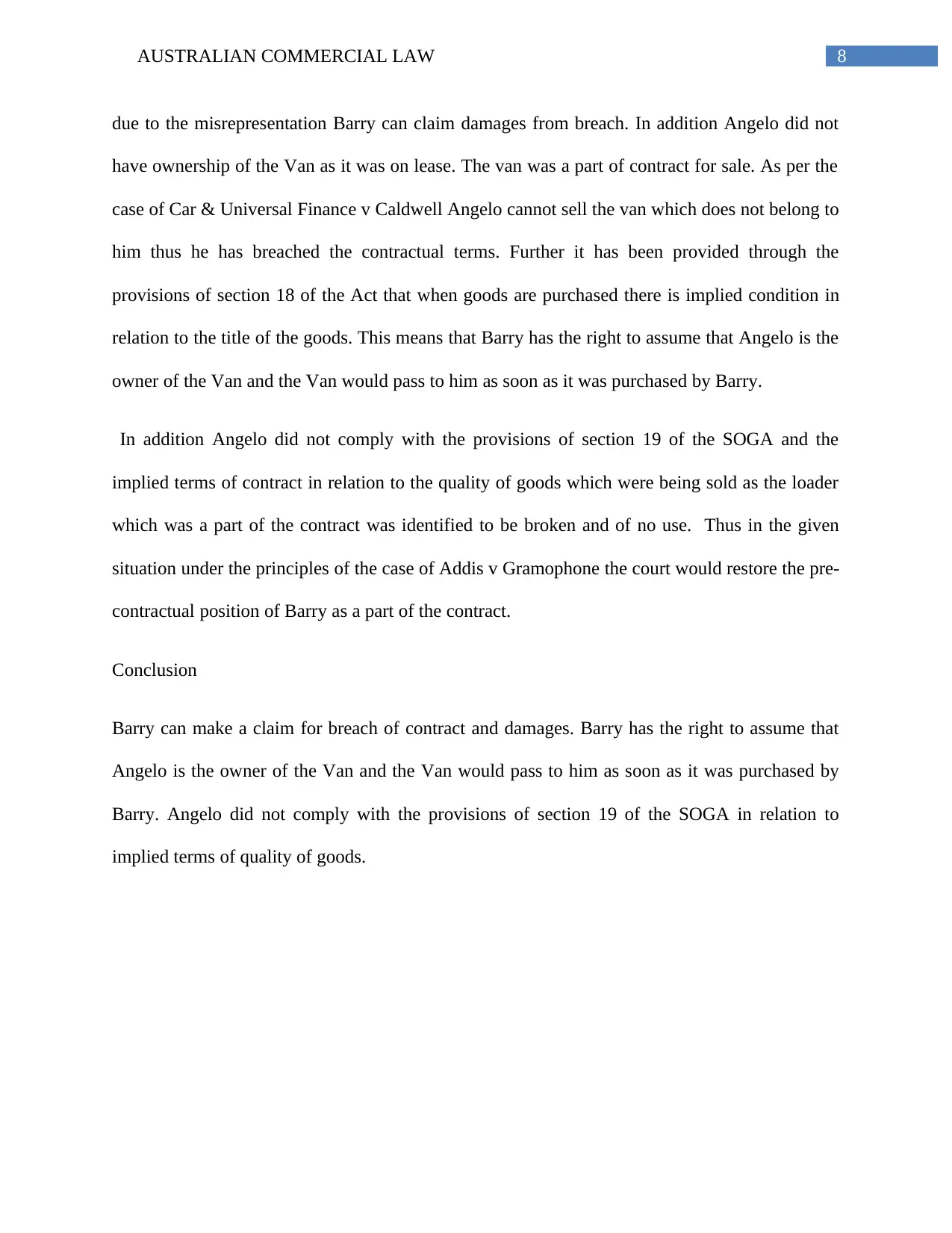
8AUSTRALIAN COMMERCIAL LAW
due to the misrepresentation Barry can claim damages from breach. In addition Angelo did not
have ownership of the Van as it was on lease. The van was a part of contract for sale. As per the
case of Car & Universal Finance v Caldwell Angelo cannot sell the van which does not belong to
him thus he has breached the contractual terms. Further it has been provided through the
provisions of section 18 of the Act that when goods are purchased there is implied condition in
relation to the title of the goods. This means that Barry has the right to assume that Angelo is the
owner of the Van and the Van would pass to him as soon as it was purchased by Barry.
In addition Angelo did not comply with the provisions of section 19 of the SOGA and the
implied terms of contract in relation to the quality of goods which were being sold as the loader
which was a part of the contract was identified to be broken and of no use. Thus in the given
situation under the principles of the case of Addis v Gramophone the court would restore the pre-
contractual position of Barry as a part of the contract.
Conclusion
Barry can make a claim for breach of contract and damages. Barry has the right to assume that
Angelo is the owner of the Van and the Van would pass to him as soon as it was purchased by
Barry. Angelo did not comply with the provisions of section 19 of the SOGA in relation to
implied terms of quality of goods.
due to the misrepresentation Barry can claim damages from breach. In addition Angelo did not
have ownership of the Van as it was on lease. The van was a part of contract for sale. As per the
case of Car & Universal Finance v Caldwell Angelo cannot sell the van which does not belong to
him thus he has breached the contractual terms. Further it has been provided through the
provisions of section 18 of the Act that when goods are purchased there is implied condition in
relation to the title of the goods. This means that Barry has the right to assume that Angelo is the
owner of the Van and the Van would pass to him as soon as it was purchased by Barry.
In addition Angelo did not comply with the provisions of section 19 of the SOGA and the
implied terms of contract in relation to the quality of goods which were being sold as the loader
which was a part of the contract was identified to be broken and of no use. Thus in the given
situation under the principles of the case of Addis v Gramophone the court would restore the pre-
contractual position of Barry as a part of the contract.
Conclusion
Barry can make a claim for breach of contract and damages. Barry has the right to assume that
Angelo is the owner of the Van and the Van would pass to him as soon as it was purchased by
Barry. Angelo did not comply with the provisions of section 19 of the SOGA in relation to
implied terms of quality of goods.
⊘ This is a preview!⊘
Do you want full access?
Subscribe today to unlock all pages.

Trusted by 1+ million students worldwide
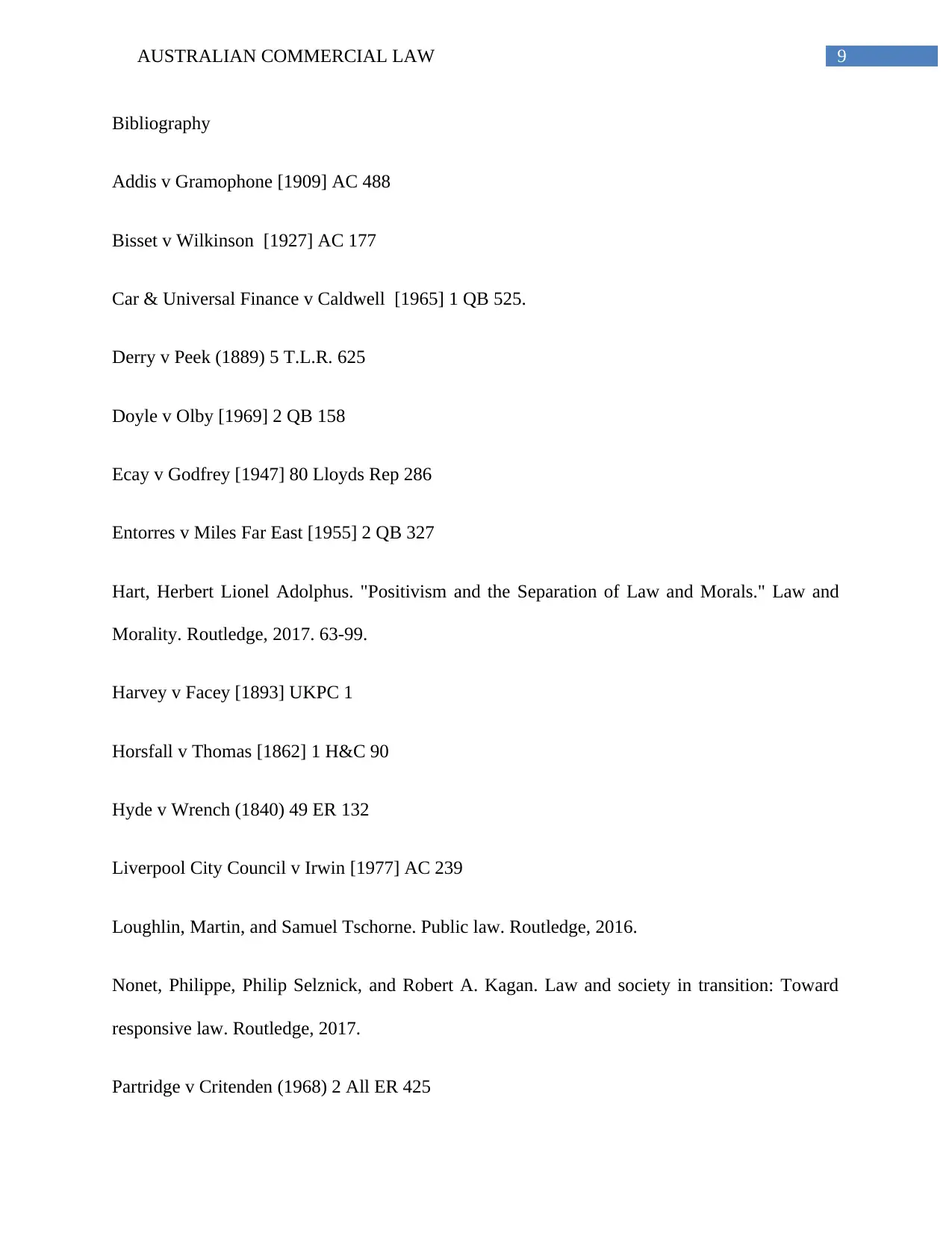
9AUSTRALIAN COMMERCIAL LAW
Bibliography
Addis v Gramophone [1909] AC 488
Bisset v Wilkinson [1927] AC 177
Car & Universal Finance v Caldwell [1965] 1 QB 525.
Derry v Peek (1889) 5 T.L.R. 625
Doyle v Olby [1969] 2 QB 158
Ecay v Godfrey [1947] 80 Lloyds Rep 286
Entorres v Miles Far East [1955] 2 QB 327
Hart, Herbert Lionel Adolphus. "Positivism and the Separation of Law and Morals." Law and
Morality. Routledge, 2017. 63-99.
Harvey v Facey [1893] UKPC 1
Horsfall v Thomas [1862] 1 H&C 90
Hyde v Wrench (1840) 49 ER 132
Liverpool City Council v Irwin [1977] AC 239
Loughlin, Martin, and Samuel Tschorne. Public law. Routledge, 2016.
Nonet, Philippe, Philip Selznick, and Robert A. Kagan. Law and society in transition: Toward
responsive law. Routledge, 2017.
Partridge v Critenden (1968) 2 All ER 425
Bibliography
Addis v Gramophone [1909] AC 488
Bisset v Wilkinson [1927] AC 177
Car & Universal Finance v Caldwell [1965] 1 QB 525.
Derry v Peek (1889) 5 T.L.R. 625
Doyle v Olby [1969] 2 QB 158
Ecay v Godfrey [1947] 80 Lloyds Rep 286
Entorres v Miles Far East [1955] 2 QB 327
Hart, Herbert Lionel Adolphus. "Positivism and the Separation of Law and Morals." Law and
Morality. Routledge, 2017. 63-99.
Harvey v Facey [1893] UKPC 1
Horsfall v Thomas [1862] 1 H&C 90
Hyde v Wrench (1840) 49 ER 132
Liverpool City Council v Irwin [1977] AC 239
Loughlin, Martin, and Samuel Tschorne. Public law. Routledge, 2016.
Nonet, Philippe, Philip Selznick, and Robert A. Kagan. Law and society in transition: Toward
responsive law. Routledge, 2017.
Partridge v Critenden (1968) 2 All ER 425
Paraphrase This Document
Need a fresh take? Get an instant paraphrase of this document with our AI Paraphraser
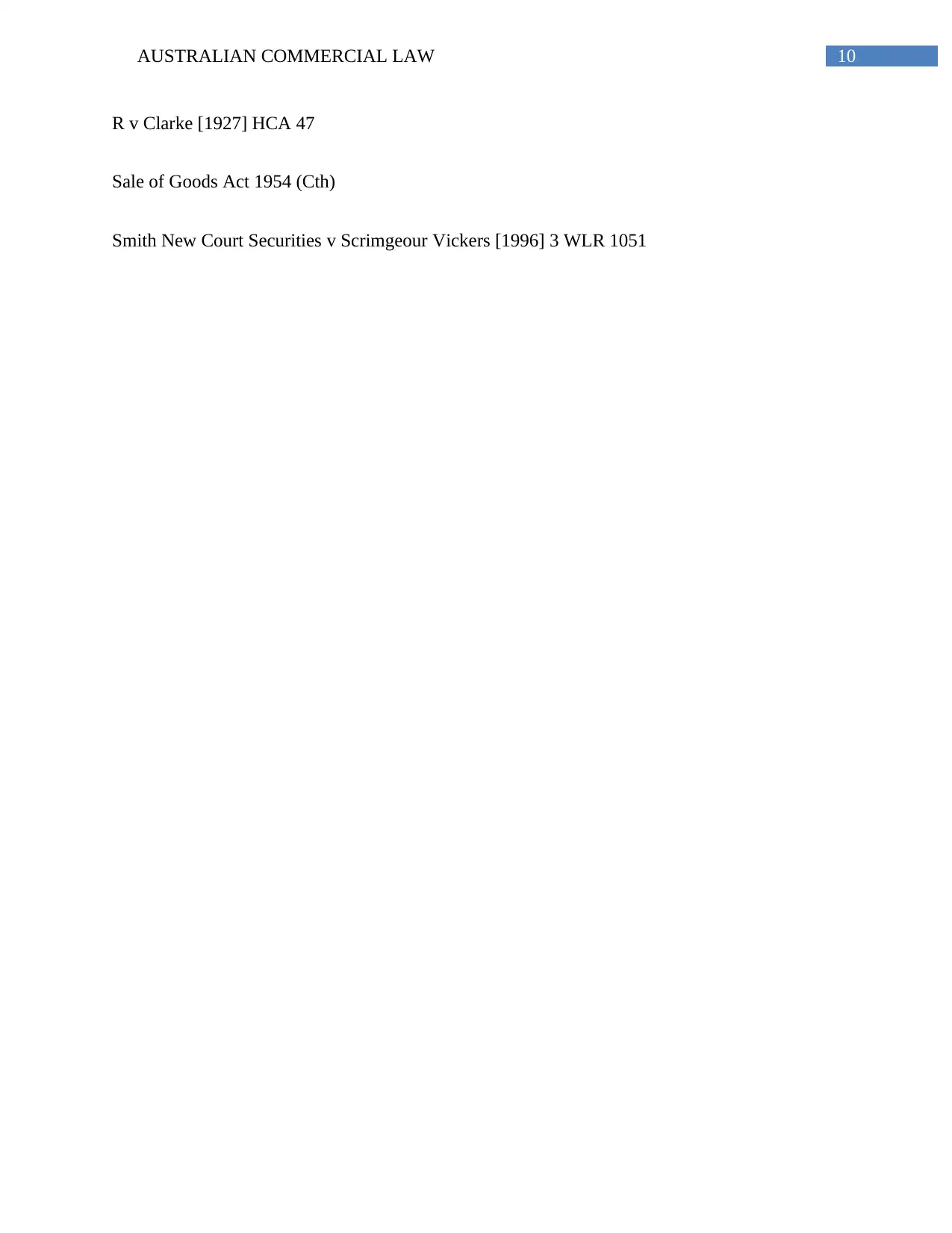
10AUSTRALIAN COMMERCIAL LAW
R v Clarke [1927] HCA 47
Sale of Goods Act 1954 (Cth)
Smith New Court Securities v Scrimgeour Vickers [1996] 3 WLR 1051
R v Clarke [1927] HCA 47
Sale of Goods Act 1954 (Cth)
Smith New Court Securities v Scrimgeour Vickers [1996] 3 WLR 1051
1 out of 11
Related Documents
Your All-in-One AI-Powered Toolkit for Academic Success.
+13062052269
info@desklib.com
Available 24*7 on WhatsApp / Email
![[object Object]](/_next/static/media/star-bottom.7253800d.svg)
Unlock your academic potential
Copyright © 2020–2025 A2Z Services. All Rights Reserved. Developed and managed by ZUCOL.





